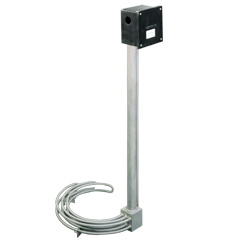Installation, Operation, and Maintenance Instructions
1.0 Handling
1.1 Unpack and handle with care to avoid damage to heater and components
1.2 Make sure heater is protected from contamination during storage. A dry environment if preferred.
1.3 Refer to Application Data link for additional information related to heater system design and selection.
2.0 Safety
2.1 WARNING: Make sure power supply is turned off before installation or service of electric heater to prevent electrical shock or damage to equipment.
2.2 WARNING: Circuit should have separate disconnect means which shall be capable of being locked in the open position and also in sight from the heater.
2.3 WARNING: Wiring must conform to the National Electric Code and Local Regulations and should be performed by a qualified electrician. Make sure wiring is of a suitable temperature rating, amperage rating, and the location.
2.4 WARNING: When servicing, handle with caution, the heater surface may be hot.
2.5 WARNING: Do not install heater into a medium or an environment that could result in an explosion, fire, or hazardous condition. Contact Vulcan regarding heaters that are specifically designed for hazardous locations.
3.0 Installation and Operation
3.1 Caution: Make sure the heater supply voltage is the same as the rated heater voltage.
3.2 Caution: Heater should be properly grounded to prevent electrical shock hazard
3.3 Caution: Do not support or suspend heater from termination or wiring
3.4 A common cause of heater failure is contamination of the the internal heater components through the termination end of the heater. Make sure the heater is protected from contamination in the final application.
3.5 Make sure heater termination is not exposed to water or other liquids. Make sure that no dripping from condensation on cold water pipes or other sources can fall on any exposed electrical wiring connections or components.
3.6. Terminations should be properly tightened and connected to hook-up wiring. A loose connection will result in overheating at the connection and could lead to premature failure. Where possible, use a wrench or pliers to prevent twisting of the terminals during installation.
3.7 It is good practice to avoid routing of thermocouples with power wiring. Use separate conduit. Thermocouples, thermostat capillary tubes, and wiring should be kept clear of heater terminals by distance or appropriate insulation.
3.8 Over The Side heaters are designed for direct immersion into a liquid. Heater tubes must be installed into the system so that the tubes are covered by liquid at all times during operation. Care should be taken to avoid air entrapment or pockets of overheated fluid around the heater tubes.
3.9 Heaters are designed for placement into tanks with the heating element portion of the assembly immersed at the bottom of the tank and the terminal enclosure above the tank.
The heating element tubes (either straight or circular shaped depending on model) provide the heat.
3.10 Support legs are provided on the heating elements to elevate the heater off the surface and away from the sludge. Make sure sludge does not build up around the heater tubes.
3.11 Heater tubes are designed for direct immersion and will fail if operated in air.
3.12 Heater wiring should be performed per diagram supplied with unit or refer to our following website page for common circuits: Common_Wiring.pdf
3.13 Do not exceed 105% of rated voltage. Higher voltages result in higher wattage output which could damage the heater, system, or medium heated.
3.14 Units equipped with a thermostat-
3.14.1 Do not exceed amperage rating of thermostat.
3.14.2 Thermostats are designed for heater control only and are not intended for use as a direct control of motors, pumps, or other devices.
3.14.3 Do not use thermostat as a power disconnection means for the heater assembly.
3.15 Check for proper installation of conduits and covers to ensure terminal box protection. Make sure gaskets seat properly on units equipped with moisture resistant terminal boxes.
4.0 Maintenance
4.1 For most applications, no heater maintenance is required.
4.2 Disconnect line switch prior to any testing or work on the heater
4.3 Check heater terminations after the initial 8 hours and tighten any loose terminal and jumper connections.
4.4 Recheck wiring periodically to ensure wiring has not become damaged, worn, or loose due to vibration or other application related conditions. Tighten, repair, or replace as needed.
4.5 Heater tubes should be checked periodically for scaling or mineral deposits on heater tubes and cleaned as required.
5.0 Trouble Shooting
5.1 WARNING: Disconnect power supply to heater(s) before performing any trouble shooting procedures.
5.2 Check supply voltage to heater to ensure there is power.
5.3 Check wiring circuit- make sure heater is properly wired and all supporting controls, relays, contactors, and other circuit related switches are also properly wired and functional.
5.4 Check heater(s)- No heat due to a heater failure is generally due to an open heater circuit. Check heater resistance across both terminals or leads. A reading of infinity (no continuity) indicates an open circuit within the element and the heater must be replaced.
5.5 Longer than normal heat up time for units with more than one heating element may be the result of an individual heating element failure.


